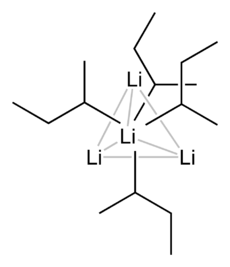sec-Butyllithium
sec-Butyllithium is an organometallic compound with the formula CH3CHLiCH2CH3, abbreviated sec-BuLi or s-BuLi. This chiral organolithium reagent is used as a source of sec-butyl carbanion in organic synthesis.[1]
 | |
 | |
| Names | |
|---|---|
| IUPAC name
sec-Butyllithium | |
| Systematic IUPAC name
Butan-2-yllithium | |
| Identifiers | |
3D model (JSmol) |
|
| 3587206 | |
| ChemSpider | |
| ECHA InfoCard | 100.009.026 |
| EC Number |
|
PubChem CID |
|
| UNII | |
CompTox Dashboard (EPA) |
|
| |
| |
| Properties | |
| C4H9Li | |
| Molar mass | 64.06 g·mol−1 |
| Acidity (pKa) | 51 |
| Hazards | |
| Safety data sheet | Fisher MSDS |
Except where otherwise noted, data are given for materials in their standard state (at 25 °C [77 °F], 100 kPa). | |
| Infobox references | |
Synthesis
sec-BuLi can be prepared by the reaction of sec-butyl halides with lithium metal:[2]

The carbon-lithium bond is highly polar, rendering the carbon basic, as in other organolithium reagents. Sec-butyllithium is more basic than the primary organolithium reagent, n-butyllithium. It is also more sterically hindered, though it is still useful for syntheses.
Applications
sec-BuLi is employed for deprotonations of particularly weak carbon acids where the more conventional reagent n-BuLi is unsatisfactory. It is, however, so basic that its use requires greater care than for n-BuLi. For example diethyl ether is attacked by sec-BuLi at room temperature in minutes, whereas ether solutions of n-BuLi are stable.[1] Many transformations involving sec-butyllithium are similar to those involving other organolithium reagents. For example, sec-BuLi react with carbonyl compounds and esters to form alcohols. With copper(I) iodide sec-BuLi forms lithium di-sec-butylcuprates. The first two reactions can also be accomplished by using sec-butylmagnesium bromide, a Grignard reagent; in fact, the latter is the typical reagent for this purpose.
References
- Ovaska, T. V. "s-Butyllithium" in Encyclopedia of Reagents for Organic Synthesis, 2001 John Wiley & Sons: New York. doi:10.1002/047084289X.rb397.
- Hay, D. R.; Song, Z.; Smith, S. G.; Beak, P. (1988). "Complex-induced proximity effects and dipole-stabilized carbanions: kinetic evidence for the role of complexes in the α-lithiations of carboxamides". J. Am. Chem. Soc. 110 (24): 8145–8153. doi:10.1021/ja00232a029.